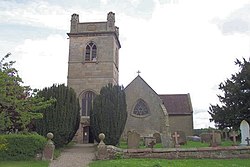Moreton Corbet
| Moreton Corbet | |
| Shropshire | |
|---|---|
 St Bartholomew's parish church | |
| Location | |
| Grid reference: | SJ561227 |
| Location: | 52°48’14"N, 2°39’8"W |
| Data | |
| Population: | 281 (2001) |
| Postcode: | SY4 |
| Dialling code: | 01939 |
| Local Government | |
Moreton Corbet is a village in Shropshire. The suffix of the village's name refers to the Corbet baronets, the local landowners. The ruin of Moreton Corbet Castle stands in the village.
Moreton Corbet stand just north of the larger village of Shawbury, and of Shrewsbury, near Stanton upon Hine Heath and the River Roden.
The village
In 1870–72 John Marius Wilson's Imperial Gazetteer of England and Wales described Moreton Corbet thus:
"A village and a parish in Wem district, Salop. The village stands on the River Roden, 3¾ miles E of Yorton r. station, and 4¾ SE of Wem. The parish contains part of the township of Preston Brockhurst, which has a post office under Shrewsbury. Pop., 255. Houses, 51. The manor and all the land belong to Sir V. R. Corbet, Bart. Moreton Corbet Castle was erected in the 16th century, on the site of a previous castle; was burnt in the civil war of Charles I].; and is now a fine ruin. Several mills are on the Roden, the church is ancient; has a tower and several stained windows; and contains ancient effigies and monuments of the Corbets charities".[1]
The ruins of the castle are Moreton Corbet's biggest attraction. Moreton Corbet has been called "one of the most exciting places to visit in Shropshire", and described as a "magnificent and unusual, ornate ruin, that is disturbingly atmospheric".[2]
The castle

- Main article: Moreton Corbet Castle
Early stages
Moreton Corbet Castle was formerly known as the Castle at Moreton Toret, and was first built by Bartholomew Toret after the Norman Conquest of England in 1066.[3] In about 1239 the castle passed by marriage to the Corbet family, which gave its name to the village. The Corbets still own the castle, but it is now managed by English Heritage.[4]
Timber defences were replaced by stone in about 1200, sand a gatehouse and the great tower were built. The great tower is said to be the earliest surviving building on the site, which would have dominated the mediæval castle. The gatehouse was most likely built in about the 13th century, forming the main entrance to the castle throughout its occupation.
Sir Andrew Corbet, a prominent royal servant, remodelled the gatehouse around 1560. He and subsequent owners aimed to preserve the fortified mediæval frontage. A panel over the gatehouse arch commemorates Sir Andrew's work and is dated 1579.
In the 18th century the castle was abandoned as a residence and soon lost its roof. Plans were prepared in 1796 to build a new house on the site, but the project was never realised and the castle remained a ruin.[4]
Parish church

The parish church is St Bartholomew, a grey stone church beside the castle. It has a Norman chancel, a later south aisle and an unusual trochoidal west window.
There is good stained glass throughout – notably the large 19th century east window, with its images of many children.[5]
The church was in the patronage of the Corbet family and has an extraordinary Corbet family pew-room built into the south wall complete with a fireplace and carved seats on three sides.
Monuments and chest tombs of members of the Cobet family fill the church. There are tablets to two Corbets who died in different wars; a large marble plaque on the west wall to Captain Robert Walter Corbet, 49th Regiment, who died of fever at Marseilles in 1855 during the Crimean War, his recorded last words Homme propose - Dieu dispose ('Man proposes, God disposes') being recorded, and another on the south wall to Captain Sir Roland Corbet, 5th Baronet, Coldstream Guards, who was wounded in the Retreat from Mons and died in France in 1915, in First World War. The latter's sword used to be displayed beneath the tablet but has been removed.[6]
Outside links
| ("Wikimedia Commons" has material about Moreton Corbet) |
References
- ↑ "History of Moreton Corbet". http://www.visionofbritain.org.uk/place/place_page.jsp?p_id=10425. Retrieved 25 April 2012.
- ↑ "Shropshire Tourism". http://www.shropshiretourism.co.uk/attractiondetails.php?estid=2197. Retrieved 12 April 2012.
- ↑ "Shropshire Tourism". http://www.shropshiretourism.co.uk/attractiondetails.php?estid=2197. Retrieved 15 April 2012.
- ↑ 4.0 4.1 Moreton Corbet Castle – English Heritage (History and Research)
- ↑ "St Bartholomew church". http://www.northshropshire.co.uk/attractiondetails.php?estid=3854#Description. Retrieved 30 April 2012.
- ↑ Francis, Peter (2013). Shropshire War Memorials, Sites of Remembrance. YouCaxton Publications. p. 148. ISBN 978-1-909644-11-3.
- Nikolaus Pevsner: The Buildings of England: Shropshire, 1958; 2006 Penguin Books ISBN 978-0-300-09642-2
